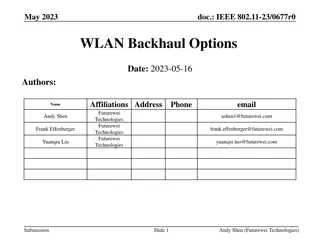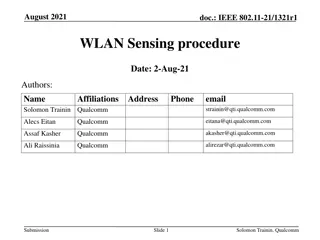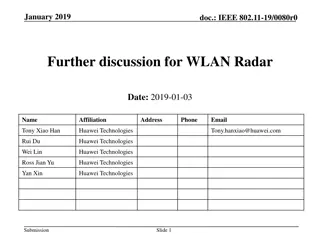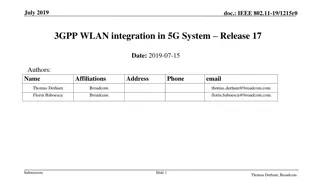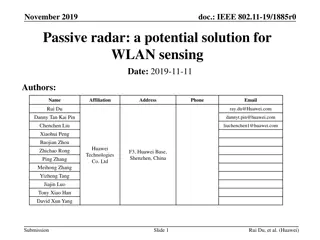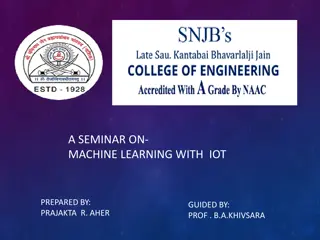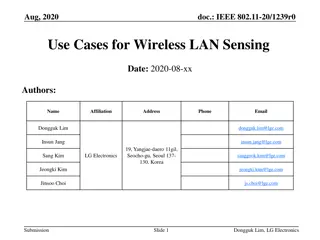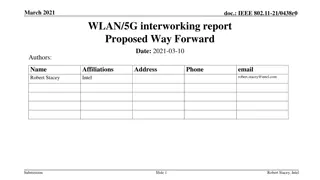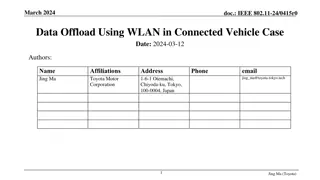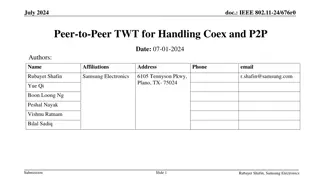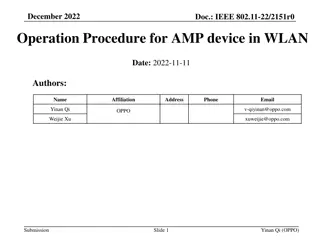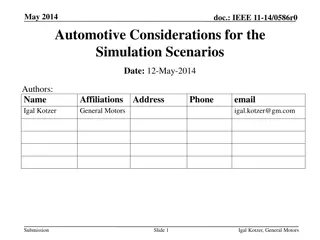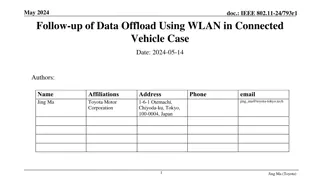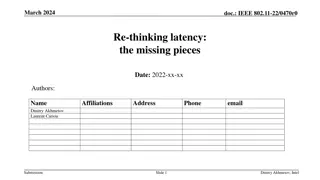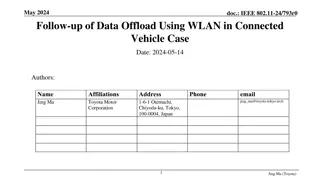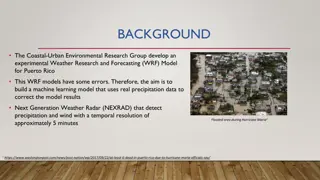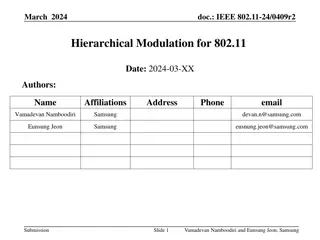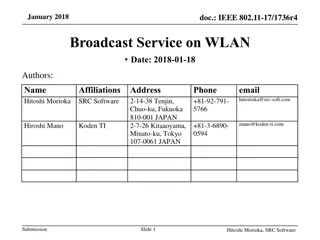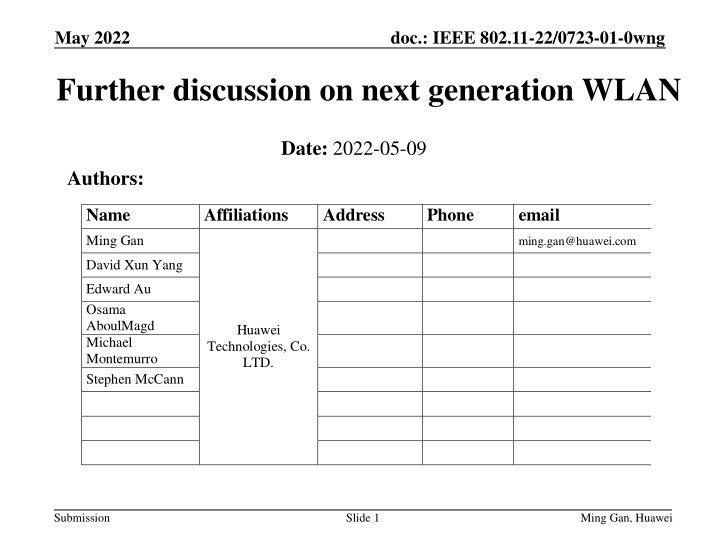
Next-Gen WLAN Machine Learning Impacts
This document delves into the potential impacts of machine learning on next-generation WLAN, focusing on use cases, frameworks, and implications for standardization efforts. It discusses target use cases, ML frameworks, and the role of ML in optimizing air interface performance. The aim is to identify key objectives and metrics for advancing beyond IEEE 802.11 standards. Detailed insights from industry experts shed light on the evolving landscape of WLAN technology.
Download Presentation

Please find below an Image/Link to download the presentation.
The content on the website is provided AS IS for your information and personal use only. It may not be sold, licensed, or shared on other websites without obtaining consent from the author. If you encounter any issues during the download, it is possible that the publisher has removed the file from their server.
You are allowed to download the files provided on this website for personal or commercial use, subject to the condition that they are used lawfully. All files are the property of their respective owners.
The content on the website is provided AS IS for your information and personal use only. It may not be sold, licensed, or shared on other websites without obtaining consent from the author.
E N D
Presentation Transcript
May 2022 doc.: IEEE 802.11-22/0723-01-0wng Further discussion on next generation WLAN Date: 2022-05-09 Authors: Name Affiliations Address Phone email Ming Gan ming.gan@huawei.com David Xun Yang Edward Au Osama AboulMagd Michael Montemurro Stephen McCann Huawei Technologies, Co. LTD. Submission Slide 1 Ming Gan, Huawei
May 2022 doc.: IEEE 802.11-22/0723-01-0wng Introduction In previous WNG SC meetings, 6 contributions [1-6] about beyond be were presented and it is expected that more and more contributions will pop up. 802.11 members are almost aligned to start a next generation beyond be activity this year (e.g., September or later). In this contribution, we will focus on the following two areas: Provide preliminary answer to the questions in the last WNG SC meeting about machine learning (ML) impact on standardization Initiate a discussion about the primary objectives and their corresponding KPIs for a beyond be activity. Submission Slide 2 Ming Gan, Huawei
May 2022 doc.: IEEE 802.11-22/0723-01-0wng Machine learning enabled use cases In reference [6], we initialized a discussion on machine learning (ML) enabled use cases, as shown below Delay insensitive use cases Delay sensitive use cases Enhanced roaming/mobility Multi-RU/channel allocation (preamble puncture, channel bonding, channel assignment) Latency/QoS optimization Distributed channel access Channel estimation Link adaptation Traffic prediction Beam management MU-MIMO MAC scheduling (user selection and resource allocation) Device level power consumption Spatial reuse CSI compression and feedback MIMO detection Next step: to continue the study of ML enabled use cases and identify target use cases that impact the specification. Submission Slide 3 Ming Gan, Huawei
May 2022 doc.: IEEE 802.11-22/0723-01-0wng An example- Machine learning framework To identify target use cases that impact the specification, we should first have a common understanding on an ML framework. An example of a ML framework[7][8] from 3GPP is shown in the figure below: Data Collection: a function that provides input data to the ML Model Training and ML Model Inference functions. It may involve the exchange of data between an AP and non-AP STA. ML Model Training: a function that creates an ML model to learn features and patterns that best represent the training data automatically. It may be time-consuming. ML Model Inference: a function that uses a pre-trained machine learning model to make a prediction and guide the decision. It is less computationally intense. Typically, there are three types of machine learning algorithms: supervised learning, unsupervised learning and reinforcement learning. ML Model Training Training Data Model Deployment/ Update Model Performance Feedback Data Collection ML Model Inference Inference Data Output Submission Slide 4 Ming Gan, Huawei
May 2022 doc.: IEEE 802.11-22/0723-01-0wng Machine learning for air interface For a machine learning framework, the AP and non-AP STA can act as different function nodes. Based on the placement of ML model training/inference functionality, the follow two types are recommended Type 1: the air interface has limited support of light information exchange, excluding the parameters of the ML model Feedback from non-AP Feedback from non-AP Non-AP (ML Model Training &Inference) AP AP (Data collection) Feedback from AP (ML Model Training &Inference) Output Non-AP ML Model Training & Inference are implemented at the non-AP STA side, but the data collection is done at the AP side and the requested data is delivered to the non-AP STA over the air The non-AP STA also provides feedback, such as performance metrics or SINR, to the AP if needed. ML Model Training & Inference and Data collection are implemented at the AP side, the non-AP STA can perform action according to the received output of ML Model Inference The non-AP STA can provide feedback, such as performance metric or SINR, to the Data Collection component as a close-looped ML framework Submission Slide 5 Ming Gan, Huawei
May 2022 doc.: IEEE 802.11-22/0723-01-0wng Machine learning for air interface Type 2: the air interface is supposed to support both model deployment and parameter updates. Feedback from non-AP Feedback from non-AP Non-AP (ML Model Training &Inference) Non-AP (ML Model Inference) AP AP Model deployment/ update Model deployment/ update (ML Model Training &Inference) (ML Model Training) ML Model Training is implemented at the AP side, ML Model Inference is implemented at non-AP STA side. The non-AP performs ML Model Inference and action according to the output of ML Model Inference The non-AP STA can provide feedback, such as performance metrics to update the trained ML Model ML Model Training & Inference are implemented at both the AP and the non-AP STA side, the general ML model is downloaded/updated from a control center-AP The non-AP STA refines the received general ML mode using it s own environment and performance and can provide feedback, such as performance metrics to update the general trained ML Model Submission Slide 6 Ming Gan, Huawei
May 2022 doc.: IEEE 802.11-22/0723-01-0wng Possible way to continue machine leaning study Exchange over the air interface in slide 5 and 6 could provide some insights on the specification impact. To have more deep understanding, we suggest the group consider the following work: Collect ML background information and reach an alignment on ML terminology. Propose some high level principles, such as Which parts of ML should be implementation specific, e.g., the detailed ML model? Where should ML functionality reside within the current 802.11 architecture? How to ensure training data represents a realistic environment, both in terms of quality and quantity, possibly with synthetic data augmented with real data? Study and specify a machine learning framework for 802.11 Create a generic ML framework, including training and inference components/functionalities Determine the placement of ML model training and ML model inference functions Specify air interfaces updates to convey the required data for AI functions Submission Slide 7 Ming Gan, Huawei
May 2022 doc.: IEEE 802.11-22/0723-01-0wng Possible way to continue machine leaning study Accuracy of a STA s ML model can also be improved by utilizing other STAs ML models. Study and evaluate the model performance under distributed and federated ML- enabled 802.11 Study and evaluate the standardization impacts for an ML model shared between two STAs or an ML model downloaded from an AP (or network server) to a STA Study and specify ML target use cases that could benefit from machine learning, including Identify a set of limited ML target use cases with their specification impacts Evaluate the standardization impacts, including data collection, input/output from the Model Training and Model Inference functions Determine the standardization impacts on the air interface to convey the necessary information/data to support the ML functionalities Align evaluation methodology metrics and data model Evaluate the performance gain of various ML based solutions Submission Slide 8 Ming Gan, Huawei
May 2022 doc.: IEEE 802.11-22/0723-01-0wng Primary objectives and KPIs for beyond be Based on the motion text about the formation of the EHT SG, we initiate a discussion about the primary objectives and their corresponding KPIs for a new beyond be amendment. Submission Slide 9 Ming Gan, Huawei
May 2022 doc.: IEEE 802.11-22/0723-01-0wng Primary objectives and KPIs for beyond be The following use cases that drive beyond be have been discussed so far Categories Use cases Metaverse, digital twin, Cloud AR/VR/XR/MR, wireless projection, 8K/16K Video High throughput Metaverse, real-time AR/VR/XR, gaming, tactile signals, Industrial PLC control, Cloud/edge computing, p2p links (distributed sharing/operation between devices) Low latency Large home/office, wireless video doorbells and wireless home security surveillance cameras Extended coverage Private Cellular networking (e.g., for IoT industrial) Reliability/manageability combat/limit climate change, e.g., carbon-neutral Device power consumption Traffic prediction, Enhanced roaming/mobility, Multi-RU/channel allocation, channel access, MU-MIMO MAC scheduling AI/ML enabled (different from other categories) The main/key use cases, such as metaverse, AR/VR/XR, urgently demand further improvement on throughput and latency Submission Slide 10 Ming Gan, Huawei
May 2022 doc.: IEEE 802.11-22/0723-01-0wng Primary objectives for beyond be Two primary objectives for this new beyond be amendment are proposed: Increase throughput for both AP and non-AP STA Improve worst-case delay bound The KPIs of these two primary objectives are: 100 Gbps for peak aggregated throughput [1] and 10 Gbps for non-AP STA with 2 spatial streams[3] Note- the above numbers are in terms of PHY data rate Less than or equal to 1 ms for worst-case delay bound in at least one scenario [6] For other objectives, such as intelligence, converge, Reliability/manageability, mobility, power consumption, we could continue to discuss them in the beyond be SG Submission Slide 11 Ming Gan, Huawei
May 2022 doc.: IEEE 802.11-22/0723-01-0wng Summary A discussion about the machine learning (ML) impact on 802.11 standardization and possible ways to continue the study of machine learning are provided in this contribution. Two primary objectives are proposed for beyond be , including Increase throughput for both AP and non-AP STA Improve worst-case delay bound Submission Slide 12 Ming Gan, Huawei
May 2022 doc.: IEEE 802.11-22/0723-01-0wng References [1] 11-22-0030-01-0wng-look-ahead-to-next-generation [2] 11-22-0032-00-0wng-next-gen-after-11be [3] 11-22-0046-01-0wng-next-generation-after-802-11be [4] 11-22-0059-00-0wng-beyond-be [5] 11-22-0418-00-0wng-considerations-of-next-generation-beyond-11be [6] 11-22-0458-01-0wng-looking-ahead-to-next-generation-follow-up [7] https://www.3gpp.org/ftp/specs/archive/37_series/37.817/37817-h00.zip [8] https://www.3gpp.org/ftp/TSG_RAN/TSG_RAN/TSGR_94e/Docs/RP- 212708.zip Submission Slide 13 Ming Gan, Huawei


